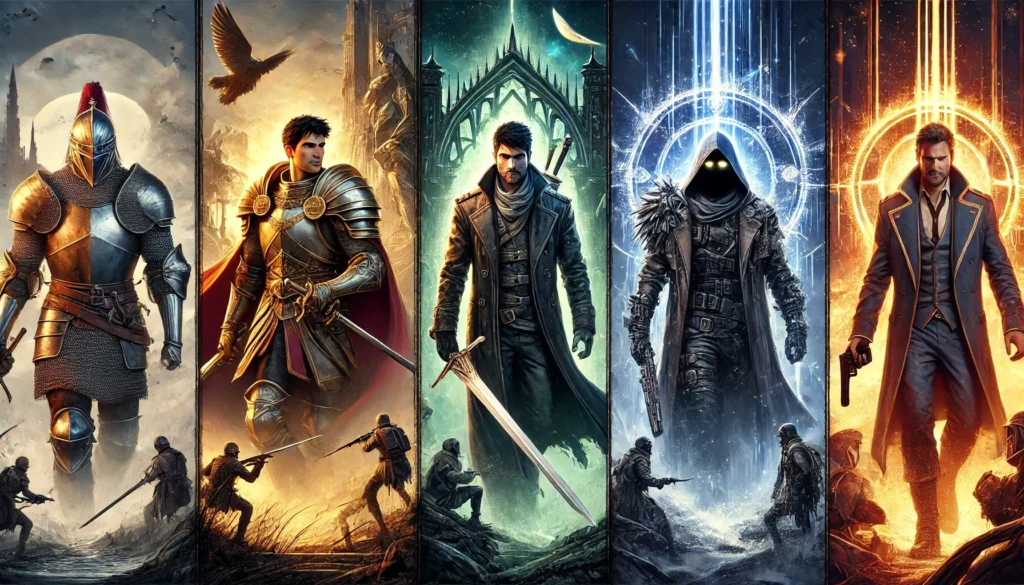
Fantasy fiction has captivated readers for centuries, taking them on journeys through enchanted forests, war-torn kingdoms, and realms beyond imagination. But just as the genre has evolved, so too have its protagonists. From noble heroes of legend to morally complex antiheroes, the central figures in fantasy literature reflect the shifting tides of storytelling and culture. Let’s explore how fantasy protagonists have changed over time and what it reveals about the evolution of the genre itself.
The Classical Age: Noble Heroes and Mythic Archetypes
Fantasy’s earliest roots lie in mythology and folklore, where heroes were larger-than-life figures embodying virtue, strength, and destiny. In ancient epics such as The Ramayana, The Odyssey and Beowulf, protagonists were unwavering in their righteousness. They battled monstrous creatures, overcame supernatural trials, and fulfilled their fates with unshakable resolve.
This tradition carried into early fantasy literature, where heroes were often noble warriors or chosen ones with a grand destiny. J.R.R. Tolkien’s The Lord of the Rings (1954) is a prime example, with characters like Aragorn and Frodo embodying classical heroism—selfless, courageous, and bound by duty. These protagonists served as moral compasses, inspiring readers with their unwavering commitment to the greater good.
The Rise of the Reluctant Hero (20th Century)
As literature evolved, so did its heroes. The mid-20th century saw the rise of reluctant protagonists—characters who were not necessarily born into greatness but were thrust into it. This shift reflected a growing desire for more humanized, relatable figures in fantasy fiction.
Frodo Baggins, for instance, is not a warrior but a simple hobbit burdened with an impossible task. Similarly, in C.S. Lewis’s The Chronicles of Narnia (1950–1956), the Pevensie children are ordinary kids who become legendary figures. These characters resonated with readers because they showed that heroism could come from unexpected places.
Later, this trend expanded into even more reluctant figures, such as Ged from Ursula K. Le Guin’s A Wizard of Earthsea (1968), who struggles with arrogance and personal demons before becoming a true mage. This era of fantasy protagonists reflected a shift toward internal struggles and personal growth, making their journeys richer and more compelling.
The Emergence of the Antihero (Late 20th Century – Early 21st Century)
The late 20th century introduced another shift: protagonists who blurred the lines between hero and villain. The emergence of darker, morally ambiguous heroes reflected a more complex world where traditional notions of good and evil were no longer black and white.
Michael Moorcock’s Elric of Melniboné (1972) featured an albino sorcerer-emperor who wielded a cursed sword that fed on souls. Unlike traditional heroes, Elric was tormented by his own nature and often walked a fine line between savior and destroyer.
This trend continued with Stephen R. Donaldson’s The Chronicles of Thomas Covenant (1977), where the protagonist is an antihero struggling with self-loathing and disbelief in the fantasy world he inhabits. Later, George R.R. Martin’s A Song of Ice and Fire (1996–present) brought forth a cast of protagonists with shades of gray, where honor and morality often led to disaster rather than triumph.
These characters reflected a growing appetite for realism in fantasy—flawed individuals who made mistakes, wrestled with difficult choices, and sometimes lost their way.
Modern Fantasy: Diversity, Subversion, and Deconstruction
In contemporary fantasy, protagonists have become more diverse than ever, breaking away from traditional molds and challenging old tropes. Female leads, protagonists from different cultural backgrounds, and characters who defy gender norms have risen to the forefront, reflecting the push for inclusivity in storytelling.
For example, N.K. Jemisin’s The Broken Earth trilogy (2015–2017) introduces a powerful yet marginalized protagonist in a world shaped by oppression and survival. Similarly, R.F. Kuang’s The Poppy War (2018) presents a heroine who is neither purely good nor evil but shaped by the brutal world around her.
Authors today also enjoy deconstructing fantasy archetypes. Patrick Rothfuss’s The Kingkiller Chronicle (2007–present) follows Kvothe, a hero whose legend is grander than the man himself, questioning the reliability of storytelling. Meanwhile, in Joe Abercrombie’s First Law series (2006–present), characters like Logen Ninefingers and Sand dan Glokta are deeply flawed, proving that even “heroes” can be ruthless and self-serving.
The Future of Fantasy Protagonists
As fantasy fiction continues to evolve, so will its protagonists. We are likely to see even more diverse perspectives, deeper explorations of morality, and further challenges to traditional heroism. Whether through reluctant heroes, antiheroes, or those who defy categorization altogether, the fantasy genre remains a mirror of the times, reflecting our hopes, fears, and ever-changing view of what it truly means to be a hero.
What are your favourite fantasy protagonists, and how do you think they’ve changed over time? Drop a comment in Contact section or send an email.
